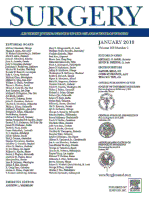Velanovich V
Surgery. 2010 Oct; 148(4):646-53.
BACKGROUND:
Several devices have been developed to create an antireflux barrier endoscopically for the treatment of gastroesophageal reflux disease. All have failed to provide long-term symptom relief, were associated with clinically important complications, or were otherwise removed from the market. A new device, the Esophyx (Endogastric Solutions, Redmond, WA), provides the closest approximation experimentally to a standard Belsy fundoplication. This report describes an initial experience with this device.
METHODS:
Patients considered candidates for endoscopic fundoplication include those with symptomatic gastroesophageal reflux disease, a small (<2 cm) hiatal hernia, objective pathologic evidence of gastroesophageal reflux disease, and an absence of other esophageal motility disorders. The procedure was conducted under general anesthesia with a surgeon operating the device and an endoscopist operating the gastroscope. H-fasteners were placed from the esophagus to the gastric cardia with the goal of creating an approximately 270-300° fundoplication approximately 3-4 cm in length. Symptom severity was measured with the GERD-HRQL instrument (best possible score 0, worst possible score 50). The patients were followed-up for complications and symptom improvement.
RESULTS:
In all, 26 patients underwent an attempted endoscopic fundoplication. Two patients could not be completed because of the inability to pass the device. Of the 24 patients who underwent endoscopic fundoplication, 20 had the typical symptoms of gastroesophageal reflux disease, 4 had symptoms of laryngopharyngeal reflux, and 4 had recurrent symptoms after a Nissen fundoplication. There was 1 major complication of a gastric mucosal tear that led to bleeding and the need for a blood transfusion. Nineteen (79%) patients reported satisfaction with their symptom relief. Of those dissatisfied, 2 had symptoms of laryngopharyngeal reflux, 1 had functional heartburn, 1 had associated gastroparesis, and 1 had clear failure with gastroesophageal reflux disease. The median GERD-HRQL score improved from 25 (interquartile range, 19.5-28.5) to 5 (interquartile range, 3-9; P = .0004).
CONCLUSION:
Endoscopic fundoplication with the Esophyx device is feasible with satisfactory initial results. Endoscopic fundoplication seems to be best suited for patients with small hiatal hernias and mild-to-moderate typical symptoms; however, subsequent trials are needed to assess the long-term effectiveness of the technique.
Link to abstract on PubMed: Velanovich V; Surgery. 2010 Oct; 148(4):646-53.


